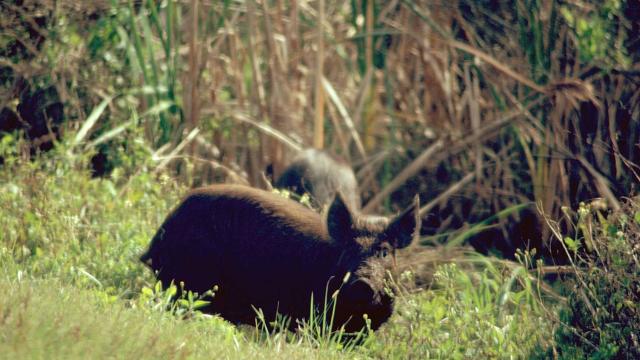New research shows that feral hogs are hungry wrecking balls in the Southeast’s salt marshes. Their appetite for mussels could end up undoing a key symbiotic relation that keeps marshland intact, right at a time when coastal ecosystems are coming under increasing pressure from climate change. As if we needed any more reasons to fear feral hogs.
Gone are the carefree days of 2019, when we could all just enjoy the seemingly risible tweet warning of the dangers posed by 30 to 50 feral hogs. The past year has revealed they’re polluting machines, and the new findings, published this month in Nature Communications, show they’re screwing up salt marshes, too. It’s not that hogs are inherently bad; they just didn’t evolve with these ecosystems. Swine first showed up in North America in the 1500s with European settlers and then arrived again in the 1900s, when Eurasian boars were imported for sport hunting.
The international team of researchers examined the impact of one of the most destructive invasive species in the U.S. on the marshland that forms a fragile coastal buffer for large portions of the Southeast. Marshes are tightly bound ecosystems, where each species of plant and animal is essential for ensuring each others’ survival in a landscape ruled by the tides and the meeting of saltwater and freshwater.
But there’s perhaps no more important relationship than that between the ribbed mussel and cordgrass. The mussels help trap sediment that allows for hummocks of marshland to pop up. There, cordgrass can flourish and provide shade for mussel beds. The study notes that cordgrass has a 98% survival rate on the mussel mounds, but that plummets to 0.01% in the marshland as a whole. These small, raised areas are key to keeping the marsh as a whole above high tide and combatting the impacts of drought.
“Most of the good inverts” — that’s ecologist speak for invertebrates — ”and animals are in the mussel mounds because there’s more structure,” said Brian Silliman, a researcher at Duke University who worked on the study. “So it’s a great little buffet right around those muscle mounds.”
The new findings show that feral hogs are out here messing up that balance by visiting the buffet a little too regularly. The researchers looked at what happened in areas fenced off from feral hogs compared to open patches of marshland. The findings show that in the open areas, “hogs completely disable” this symbiotic relationship. The pigs just can’t seem to get enough mussels. (Which, honestly, relatable. But still, bad pigs!) As a result, they trample the cordgrass, and the research shows total biomass in the hog-overrun plots was 48% lower. Mussels in those plots almost all but disappeared.
The hogs’ hunt for mussels impacted other creatures, with the research finding that the number of crabs also dropped. Worse still, the hungry hogs decimation of the mussel population put stress on marshland as a whole. Marshes that had been scavenged for mussels became patchier and had less of an ability to respond to other stressors such as drought, according to drone imagery captured by the researchers.
The group modelled the recovery time from drought for marshes with and without hogs and found the presence of wild pigs meant marshland recovery can take up to 100 years, compared to a decade or less for marshes that are pig-free. Silliman said without the mussels, “the marsh is no longer keeping up with sea level rise” and will actually end up sinking below the waves and losing biodiversity.
“Those are such healthy areas of the marsh, it’s like a marsh spa,” Silliman said. “The mussels provide nutrients for the grasses. They retain water, so there’s less salt buildup, and they harbour lots of crabs that eat the snails that eat the grass. There are all these benefits where grasses live with mussels.”
In short, the hogs are messing up all that. And in an era of climate change, as sea level rise, climbing temperatures, and other impacts will put pressure on the natural world, that’s a huge issue. The damage will escalate if actions aren’t taken. But there are solutions out there, including hiring human hunters to track down the porcine culprits and reintroducing predators like wolves, bears, or mountain lions (which Silliman noted is a misnomer, instead referring to them as “American lions,” given their adaptability). Doing so could help marshes — and by extension, us.
“Managing for partnerships and biological symbioses is really important,” Silliman said. “We need to systematically inject all the positive interactions we pulled out [of ecosystems]. The good news is we have to do lots of carbon emissions reductions, but our hands aren’t tied locally. There are things we can do that can have a huge impact.”
